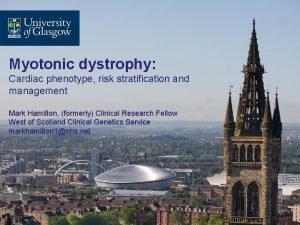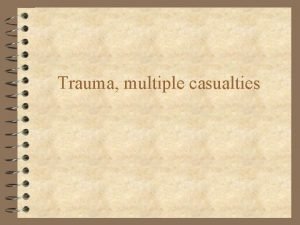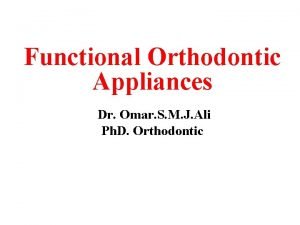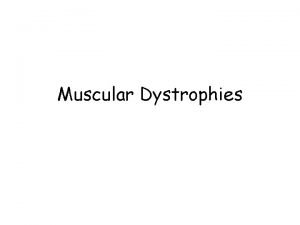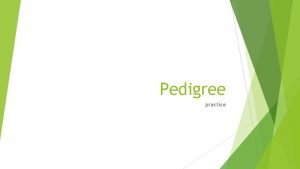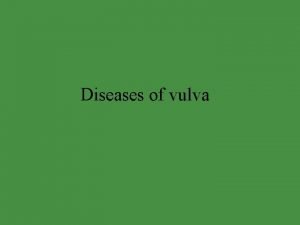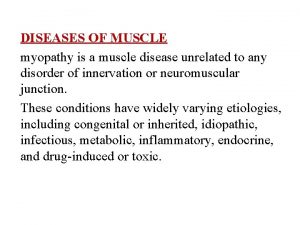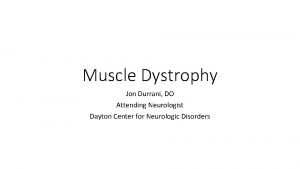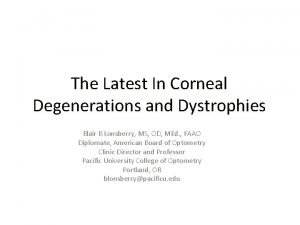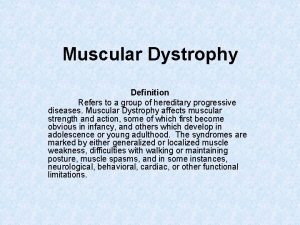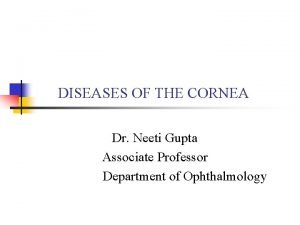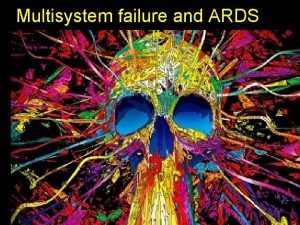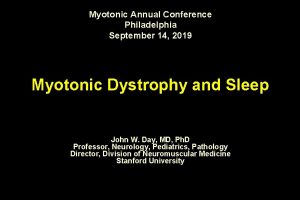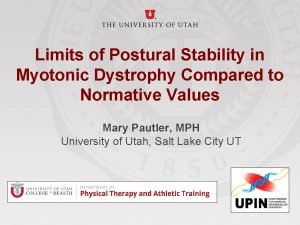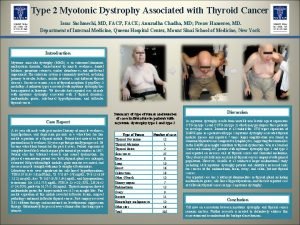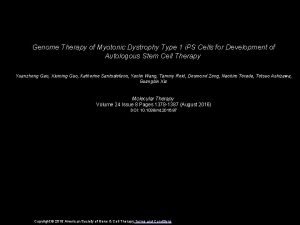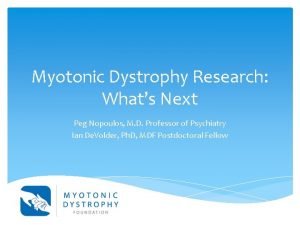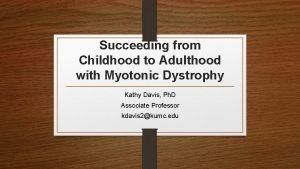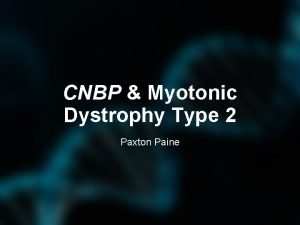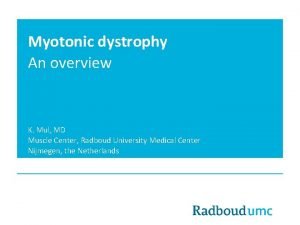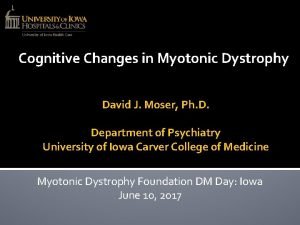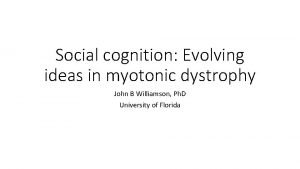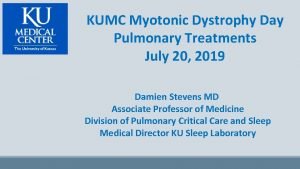Myotonic Dystrophy DM 1 A MultiSystem Condition Kirsten














- Slides: 14

Myotonic Dystrophy (DM 1) A Multi-System Condition Kirsten Patterson (Genetic Specialist Nurse) 24 th October 2018

Jacqueline Donachie Ø Scottish artist Ø Sister has myotonic dystrophy Ø Short film "Hazel, " which highlights several different sets of sisters like the Donachie’s. https: //vimeo. com/170772111

Classification Mild DM 1 (symptoms usually after 40 years) - cataracts and mild myotonia (sustained muscle contraction); life span is normal. Ø Classic DM 1 (symptoms 20 -40 years) - muscle weakness and wasting, myotonia, cataracts, and often cardiac conduction abnormalities; adults may become physically disabled and may have a shortened life span. Ø Juvenile DM 1 (symptoms between birth and adolescence) – muscle hypotonia, tiredness after physical exercise. gastrointestinal problems and learning difficulties, will likely become physically disabled and may have a shortened life span. Ø Congenital DM 1 (symptoms at birth) - muscle hypotonia and severe generalized weakness, often with respiratory insufficiency and early death; learning disability is common. Ø



Muscles Ø Symptoms range from mild to severe. Ø Particularly involving face, jaw, neck, distal limb muscles. Ø Pain may be an issue. Ø Myotonia can lead to problems with grip. Ø Can affect speech and swallowing. Ø Can give a lack of facial expression Ø Referrals can include SLT, PT and OT.

Heart Ø May be involved even without symptoms Ø Annual ECG advised for early detection of conduction defects. Symptoms suggestive of cardiac arrhythmia: l Palpitations, syncope, blackouts, fainting, dizzy spells. Ø Referrals may include holter monitor (R test), Echo, Cardiology Consultant

Respiratory System Ø Chest infections may result from diaphragm weakness/ aspiration Ø Impaired ventilation (especially at night) Signs of nocturnal hypoventilation: Ø Morning headache, lethargy, disturbed sleep, noisy sleep (snoring) Ø Referrals may include to Respiratory consultant/ sleep clinic Flu and pneumonia vaccinations advised

Anaesthetic and Sedation Increased sensitivity to sedatives, inhaled anaesthetics and neuromuscular blockade Ø Essential for anaesthetist to be aware of diagnosis for risk assessment and post operative planning Ø Detailed anaesthetic guidance is available on the Scottish Muscle Network website www. smn. scot. nhs. uk Ø Alert card and Key Ring for all patients, as well as electronic alerts – Trak/ ACP/ KIS. Ø

GI/ Liver/ Endocrine Ø Constipation, diarrhoea, indigestion and abdominal pain are common but might need further assessment to rule out other causes. Ø LFTs may be abnormal – recommend further investigation – annual LFTs Ø Risk of Diabetes – annual Hb. A 1 c Ø Risk of Hypothyroidism – annual TFT Onward referral depends on symptoms

Cognition Ø Excessive day time sleepiness (CNS involvement) – Epworth Score Ø Apathy and lack of initiative Ø Executive function can become affected leading to greater difficulty in organising and performing routine activities (paying bills, keeping appointments, arranging schedules, etc. )

Epworth Score: Sitting reading: 0 Would never dose Watching TV: Sitting in a public place: 1 Slight chance of dozing 2 Moderate chance of dozing Passenger in car > 1 hour: Lying to rest in afternoon: Sitting and talking to someone: 3 High chance of dozing Sitting quietly after lunch (no alcohol): > 12 refer to sleep clinic In a car stopped for a few minutes in traffic:

Genetic Counselling – Autosomal dominant A parent with an autosomal dominant condition has a 50% chance of having a child with the condition. This is true for each pregnancy. Ø The signs and symptoms of some genetic conditions tend to become more severe and appear at an earlier age as the disorder is passed from one generation to the next. Ø l Ø Anticipation A mother with DM 1 is more likely to have a baby with congenital DM.

 Myotonic dystrophy
Myotonic dystrophy What is the definition of multisystem trauma?
What is the definition of multisystem trauma? Philosophy of frankel appliance
Philosophy of frankel appliance Controlled radius
Controlled radius Duchenne
Duchenne Signs of duchenne muscular dystrophy
Signs of duchenne muscular dystrophy Pedigree charts practice
Pedigree charts practice Duchenne muscular dystrophy
Duchenne muscular dystrophy Duchenne muscular dystrophy
Duchenne muscular dystrophy Vulvar dystrophy thyroid
Vulvar dystrophy thyroid Becker muscular dystrophy
Becker muscular dystrophy Jon durrani
Jon durrani Mooren ulcer
Mooren ulcer Muscular dystrophy definition
Muscular dystrophy definition Salzmann's nodular dystrophy
Salzmann's nodular dystrophy
